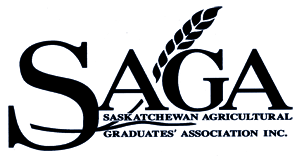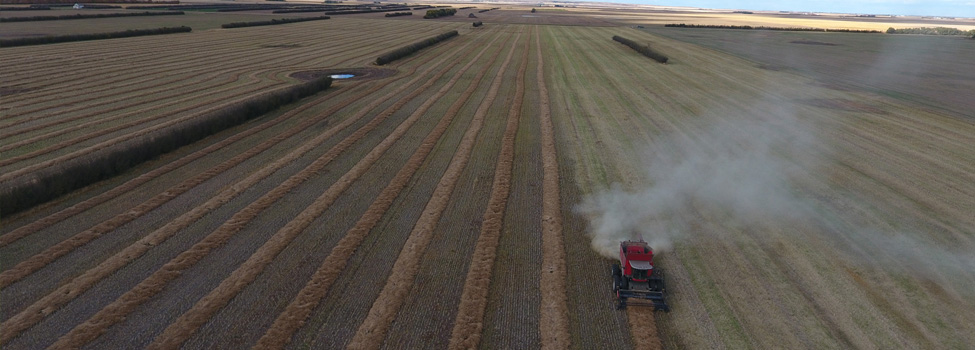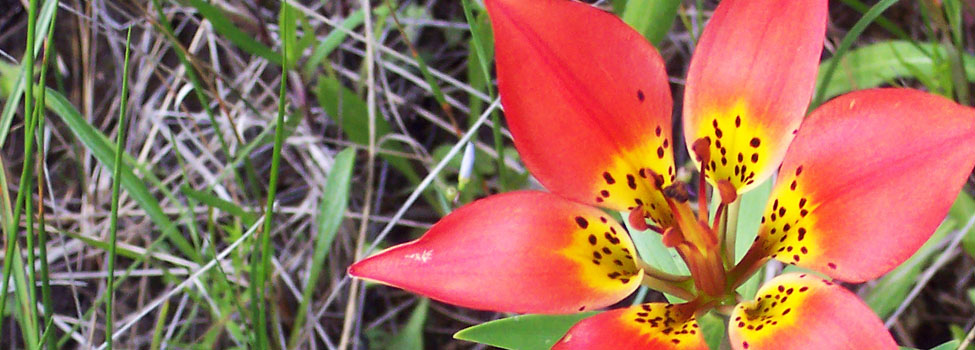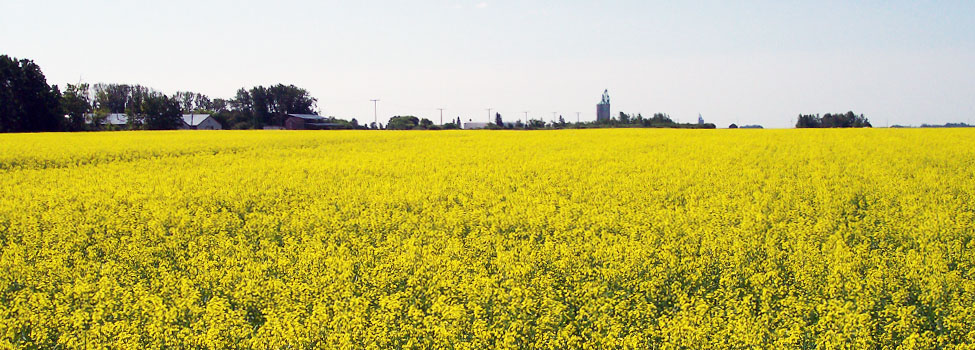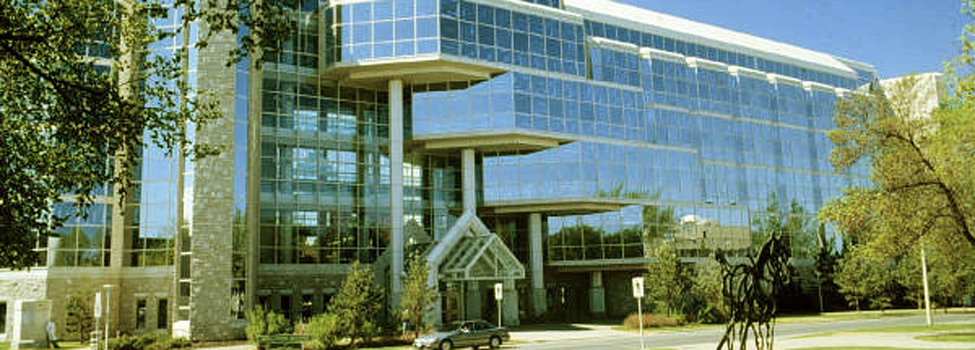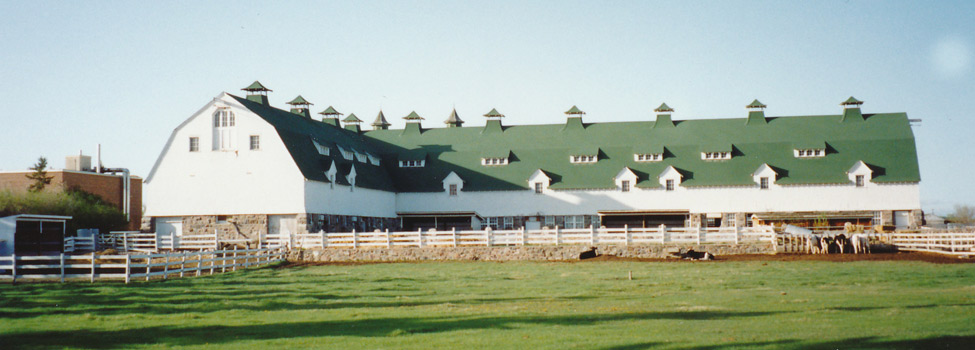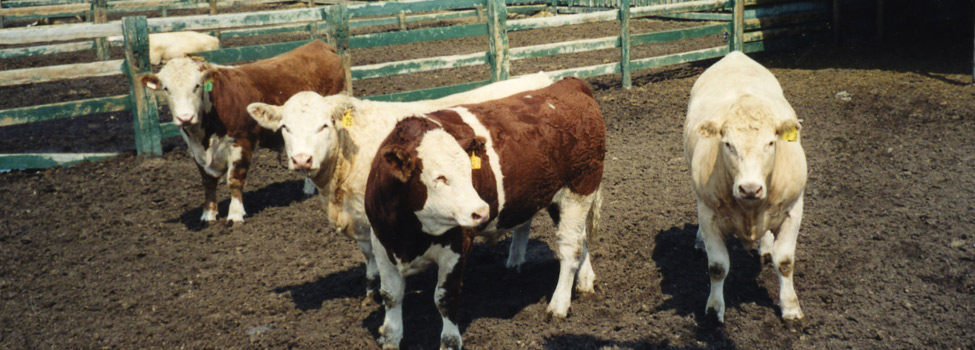History of Animal and Poultry Science
A Brief History of the Department of Animal and Poultry Science
January, 2016
Our beginnings: In 1903 the Territorial Government under Premier Fredrick Haultain introduced a Bill of Ordinance to establish the University of Saskatchewan. In 1907 the University Act was passed. Agriculture Minister W.R. Motherwell favored a College of Agriculture separate from the main university. President W.C. Murray was instrumental in the decision that a College of Agriculture be integrated into the University of Saskatchewan. That decision was made in November 1908. The College would consist of Departments of Animal Husbandry, Field Husbandry, Dairy (Processing) and Bacteriology, and others as may be necessary. Minister Motherwell moved his Deputy Minister W.J. Rutherford to become Agriculture Dean and Animal Husbandry Department Head in 1910. The Animal Husbandry Department was located on the first floor of the College Building in rooms that now have the numbers 112 to 118. The first three Animal Husbandry faculty were W. J. Rutherford, A. M. Shaw and W. H.T. Tisdale. At the north end of the first floor were two classrooms and an Animal Husbandry museum. These were not completed until 1912 The first Farm Manager was Valentine Rowan, appointed in 1909 and replaced by Thomas Brydon in 1912 who served until retirement in 1948. In 1913 Raymond K. Baker was appointed as Assistant Professor of Poultry Husbandry.
Department Heads, Department of Animal Husbandry, and Animal and Poultry Science.
W.J. Rutherford, 1909 to 1930. Dean and Department Head
A.M. Shaw, 1930 to 1937. Dean and Department Head.
J.W.G. MacEwan, 1937 to 1946.
A.H. Ewan, 1946 to 1953. Professor Ewan was required to resign and returned to Scotland.
J.M. Bell, 1953 to 1975. The Department name changed to Animal Science in May of 1962.
C.M. Williams, 1975 to 1983.
D.A. Christensen, 1983 to 1994.
B. Laarveld, 1994 to 2005.
H.L. Classen, 2005 to 2011.
A. VanKessel, 2011 to present (2016)
Department Heads, Department of Poultry Husbandry.
R.K. Baker, 1916 to 1942.
W.J.Rae, 1942 to 1965. Name Change to Poultry Science about 1962.
J.B. O’Neil, 1965 to 1976. The Department was amalgamated with Animal Science in 1976 to form the Department of Animal and Poultry Science.
Farm Managers.
T. Brydon, 1912 to 1948.
R.F.J. Hopkinson, 1948 to 1953. He was allowed to resign due to a situation that also resulted in Professor Ewan’s resignation.
O.B. Young, 1954 to 1973.
G. Francis, 1974 to 1998.
D. Bradley, 2000 to 2008.
On Doug Bradley’s retirement he was replaced by three unit managers.
Teresa Binetruy, Beef Cattle Research and Teaching Unit, 2008 to present.
Marlene Fehr, Dairy Cattle Research and teaching Unit, Rayner Dairy and Livestock Research Building, 2008 to 2014. Replaced by Morgan Hobin, 2014 to present.
Karen Schwean-Lardner, Poultry Research and Teaching Unit 2008 to 2014, replaced by Centaine Raginski, 2014 to present.
Departmental facilities.
At its inception the College of Agriculture was recognized by the Provincial Government as a major teaching and extension facility as well as a major resource for applied research, and as such required a substantial land base. An area of 1333 acres was purchased for the University at a cost of $147,906. About 300 acres were set aside for the main campus. Most of one quarter section was allocated for plot work under Field Husbandry direction and 50 acres for Animal Husbandry farm buildings, paddocks, lanes and small pastures. The remaining 830 acres were to be used for wheat production and for pasture. This area was the responsibility of the Animal Husbandry Department, including provision of the horses needed for field and plot work.
Farming operations started in 1911 and horses were essential for all hauling, field and plot work.An exception was the one International Harvester 45 HP Mogul tractor used to break land and to run a threshing machine.
By 1910, 19 horses had been purchased that were good work horses or suitable for student class work. Two were purebred Clydesdales. Three light horses were also purchased. One named Barney was used in the morning to deliver milk to faculty in Nutana and in the afternoon on the buggy as Dean Rutherford made his farm rounds. In 1920 the Province asked the Animal Husbandry Department to establish a Clydesdale breeding stud. This led to development of an outstanding collection of prize winning horses that became a focus of the Department. In the 1920s the Percheron and Belgian breeders also demanded support for their breeds and so they were included in the university stud and some cross breeding was undertaken. The campus horses were used for field work for all Departments, general hauling and site work for new buildings. An unofficial use was for the Lady Godiva ride across campus each fall. By the 1940s it was clear that the era of horses as a main source of farm power was over. The Department was slow and reluctant to change. Research papers were few and after world war II, new research orientated PhD grads were available and looking for academic positions. The Animal Husbandry Department was not receptive to change or the needs of qualified researchers such as Bob Forshaw who left in 1947 for Guelph, or Jack Weir who left in 1951 for Kansas State. This period marked a change in agriculture and rural life. There was rural farm electrification, all weather roads and returning veterans with a new level of skills in mechanics and machine operation and manufacture. Chemical fertilizer blends became available.
The academic climate changed with the hiring of J.M. Bell in 1948, W.E Howell in 1951 and the controversial and obligatory resignation of Department Head A. Ewan and Farm Manager F. Hopkinson in 1953 following investigation of Farm and Department operations and complaints by students concerning teaching.
The original Department facilities included office space in the College Building, the Main (Stone Barn), a pig barn, sheep barn and The Poultry Building. There were a number of paddock and sheds and shelters. In the 1930s a small feedlot was constructed for finishing cattle from the Matador project for the British export market. These subsequently became part of the sheep housing.
When Milt Bell was appointed Animal Husbandry Head in 1953 the Department together with the Extension Department was the main sources of livestock producer information. With only two PhD faculty and nonexistent modern research facilities it was impossible to meet farmer and industry demands and to initiate meaningful research. Bell wrote briefs to university administration, to the provincial government and made a presentation to Saskatoon City Council. These were stressful times and the university solicitor who attended the city council meeting to support Bell died of a heart attach the next day. Milt Bell’s proposals were effective and set the direction of the Department for the next 50 years. A series of appointments and provision of new facilities was undertaken. C.M. (Red) Williams was appointed to faculty in 1954 and initiated beef and dairy physiology research. Years later when his hair had faded to grey a secretary asked, “why is he called Red, he is a well-known Liberal”? Bruce Owen was hired in 1957 as a lecturer and to do PhD studies. He was instrumental in establishing new analytical laboratory capacity and in working with Milt Bell on swine nutrition and management. Hugh Nicholson was hired away from Agriculture Canada in 1962 to plan and construct a new feedlot, bull test station and feedmill. The feedlot was surrounded by 20% porosity fence designed by Eric Moisey and Bill Lampman in Agricultural Engineering using wind tunnel technology. This was a first in the world concept, now used world-wide. Wind turbulence is diminished downwind for three times the height if the fence. These beef and feed mill facilities were completed in 1965. Bell’s presentation to city council paved the way for their construction on the edge of the city. The feedlot and feedmill were used to develop and confirm the use of high concentrate barley based feedlot rations. Other cereal grains and byproducts were evaluated. David Christensen was hired in 1965 as a nutritional biochemist with responsibility for establishing amino acid analysis, additional lab methods and to make use of the dairy herd for nutrition and management research.
The Department moved offices in 1950 from the College Building (now McKinnon Building) to the Swamp Fever Research Facility, shared with J.S. Fulton until the Fulton Virus building was completed. This renovated barn was located near the walkway to the Veterinary College. This was not a welcome move by Fulton as he periodically locked the access doors.
This problem was solved when Milt Bell pointed out directly to Fulton that the next time this happened he would remove the door and personally and physically present it to Fulton. Dr. John Miller also used part of the building as a provincial pathology lab. Dr. Miller also taught an undergraduate animal health and disease course to Animal Husbandry students.
The dairy industry was changing with a move to shipping whole milk rather than cream. With rural electrification it was possible to cool milk with refrigerated bulk tanks. Dr. Douglas Gibson was head of the Dairy Science Department and helped fund a new dairy barn complete with milking parlour and bulk tank. This loose housing, or loafing barn, was constructed east of the Stone Barn in 1949 and was in use until 1972 when a well-designed research barn was constructed with tie stalls, free stalls and a mechanized total mixed ration feeding system, and milking parlour with a viewing area. Funding for this new barn was from the University, Cattle Check-off Funds and industry. This research and teaching unit was used in many studies on forage quality including barley silage cultivars and stage of maturity at harvest. These studies included evaluation of processed alfalfa products, development of trace mineral supplements and evaluation of protein sources such as canola meal. Early studies on growth hormone and thyroid function were conducted. By 2000 new housing systems for western Canada had proven superior while the existing facilities limited the herd size to 55 milking cows and correspondingly limited research capacity. Planning of a new facility was led by Bernard Laarveld and dairy industry representatives. With funding from Federal and Provincial governments, dairy producers industry and a private donor the $12 million facility came into use in July 2013. It houses up to 120 milking cows in free stalls, box stalls, and a metabolic unit. Cows can be milked in a double 6 parlour, a robot or in the metabolism stalls. Cows can be fed individually in metabolism stalls or by individual computer feeders or by feed bunk.
Poultry Facilities: The original Poultry facilities limited the scope of research. On amalgamation of the Department with Animal Science in 1976 Jim O’Neil retired and was replaced by Hank Classen. Jim O’Neil was the first Registrar (1946) of the newly formed Saskatchewan Institute of Agrologists. Roy Crawford (BSA 1955) had joined the Poultry Department in 1964 (replacing W. Rae) and continued his genetic research until retirement in 1991. One of his many contributions was editing and contributing 5 chapters to “Poultry Breeding and Genetics”, a 325 page classic tome with a current retail price of $US 1,225. In 1985 a new poultry facility was opened by Agriculture Minister Lorne Hepworth. These consisted of the Brooding and rearing barn (housing broilers) and Adult barn (housing the laying hen facility). The brooding and rearing barn currently holds up to 9000 broilers and 1500 turkeys. A room in this barn is dedicated to a small cage facility for small scale and feeding trials (housing up to 650 broilers). The laying hen facility originally housed A-frame cages, with a capacity of 3000 hens. Somewhere around 1994, some of these cages were replaced with 10 large group, enriched cages. In 2007, the A-frame cages were replaced with conventional cages. Current capacity is now 6000 hens. In 1999, the adult barn (housing the laying hen facility) had a south wing added to it, for our Ridley Bronze turkeys, which were dispersed in 2008. In 2008, this wing underwent upgrades to the ventilation and management system. It can hold approx. 600 turkeys. Also in 1999, the hatchery was constructed, with an incubation and hatching facility for teaching and research, and to allow us to maintain our genetic stocks: Barred Plymouth Rocks and mixed breed that carries a gene for epilepsy. The gnotobiotic facility is a wing in this building. Ducks and geese were housed in an outdoor facility until they were dispersed in 2008.
The Department of Animal and Poultry Science was one of the first to appoint an animal behavior specialist. Ray Strickland joined the Department in 1977 and initiated undergraduate and graduate courses in Animal Behaviour. He conducted a range of research studies and supervised a number of graduate students before moving to the University of Maryland in 1982. One PhD graduate, Harold Gonyou, joined the Prairie Swine Centre and continued Animal Behavoir research and teaching.
In international activities, Milt Bell explained the improved properties of canola meal through seminars and trade missions in Russia and Asia beginning in 1978. The Department took part in a twinning arrangement with Makerere University in Uganda to develop a graduate program, construct a feed mill and a nutrition Lab in 1970 to 1972. The department also supported CIDA projects in Swaziland and Malawi from 1976 to 1985. Research on dehydrated alfalfa products began in 1976 and led to market development activities in Asia from 1979 to the mid-1990s. Two department members (Williams and Christensen) took part in a baseline study of grassland restoration strategies for China in 1990 and participated in a number of follow-up studies. One was the initiation of a linkage with China Agricultural University (CAU) to establish the Ministry of Agriculture Feed Information Centre (MAFIC). In these projects key support was provided by Vern Racz (BSA 1968). Phil Thacker contributed greatly to technical support of this CAU unit and his contributions were recognized by the National Government. Paul Stevens headed a major extension and training project supported by CIDA and the University of Saskatchewan in Mongolia. Although the Mongolia projects ended in 2009, cooperation continues with the Deputy Minister of Education spending two years (2015-17) in our department to study feed processing and beef production methods.
In 1987 the Main (Stone) Barn was taken out of use. The drainage system had collapsed, ventilation and manure handling were inadequate. Later questions were raised about structural soundness of the foundation. In 1989 a new metabolism barn was constructed. The location is north of the Stone Barn where a sheep barn was demolished. This unit is used for intensive metabolic work and was used for lambing until the flock was dispersed in 2013. Part of the west wing has been developed as an aquaculture research and teaching facility. Fish feeding systems to use plant material to replace fish meal and oil has been a major direction of research and led to national and international recognition.
In 1966 a Feed Testing Laboratory was developed in a service building that also came to house the Soil Testing Laboratory. Bruce Owen was instrumental in establishing the Feed Testing Lab with Provincial and livestock checkoff funds. Ernie Spencer became the first Laboratory Director on completion of his MSc, and a number of years later was replaced by Ken Mitchell when Ernie joined the Provincial Government. In 1983 Ken resigned for health reasons and Vern Racz left his job as Provincial Swine Specialist and Directed the Lab until its closure in 1995. Commercial Laboratories had become established by that time. On closure of the Feed Lab the Prairie feed Resource Centre (PFRC) was formed with Vern Racz as Executive Director. This organization provided technical feed related research and development to support industry and producers at home and abroad and to complete its adoption provided a consulting service. On Vern Racz’s retirement in June 2006 he was replaced by Colleen Christensen as Commercial Director in 2007. An Advisory Board from the University and Industry continued to provide support. PFRC was restructured as the Feeds Innovation Institute (FII) in 2009 with Colleen Christensen as Executive Director. Tom Scott replaced her in 2011 and he was appointed as Ministry of Agriculture Feed Processing Chair. By 2005 it was clear that the Campus Feed Mill was becoming obsolete. Rather than upgrade the existing mill plans were developed in 2005 for a modern feed processing facility with funding obtained from the Canadian Foundation for Innovation (CFI) led by Bernard Laarveld. Marked escalation in construction costs in Saskatchewan during the extended fund raising period made new construction unfeasible and led to the purchase of an existing commercial scale feedmill in North Battleford to which pilot-scale and lab-scale capacity was added. An agreement was made with Cargill for that company to lease the commercial line. Cargill also became a major sponsor along with the provincial and federal governments. This facility, termed the Canadian Feed Research Centre (CFRC), came into use in 2011 with Tom Scott responsible for research and graduate student supervision. An experienced feed mill operator, John Smillie, was hired to manage CFRC mill operations. Sean Thompson was hired to provide industry liaison and technical support. Tom Scott resigned in June 2015 with Rex Newkirk replacing him as of November 1, 2015. The CFRC plant is currently producing research rations, supporting feed processing and nutrition research and graduate student training in a form that is not available elsewhere in Canada.
The original pig barn was completed in 1912. It is no longer standing but was located near the present Livestock Research Building (LRB). Its main feature was 19 pens and a service area along a central feed alley. The pens allowed flexible use for breeding sows, boars and growing finishing pigs. Outdoor pens were also in use. A variety of breeds were kept and used for crossbreeding until 1929 when the main breed became Yorkshire. At that time pigs had 14 or 15 pairs of ribs. One of the 1920s projects was to select for 17 pairs of ribs. A new swine barn was completed in 1956 designed by Milt Bell to include sows but mainly for advanced nutrition research with growing finishing pigs. Much of the early nutrition research on rapeseed and canola meal and on barley based rations was conducted in this facility. Bell also established a research mouse colony as a pilot animal for swine research and did much to popularize the mouse as a medical research tool. With the establishment of the Prairie Swine Centre in 1980 it was used only for growing finishing swine and fell out of use when Milt Bell retired in 1989. This barn was then used to house the Crawford collection of rare poultry breeds until they were phased out and moved mainly to the University of Alberta. It is now under renovation as a calf barn and research facility. The Aquaculture Centre has developed international linkages, mainly in northern Europe.
In 1980 the Prairie Swine Centre was constructed in the Floral District about 10 km SE of Saskatoon. The five components cost two million dollars with support from Saskatchewan Agriculture Department, the University of Saskatchewan the Saskatchewan Hog Marketing Commission and eleven commercial sources. The Deans of Agriculture and WCVM and Engineering were responsible for the budget and general management together with an advisory Board. By 1984 the PSC had a $300,000 deficit. The University considered closing the facility, instead budget and operational decisions were transferred to the Head of the Animal and Poultry Science Department. In 1987 the PSC operating structure was changed to make it an independent unit with budget separate from the University and a more involved Advisory Board. That structure continues in place with researchers holding adjunct appointment in Animal and Poultry Science allowing supervision of graduate students under that Department’s graduate student program.
The 1900 acre Termuende Farm was transferred to the university in 1974. The Termuende family had moved to the farm near Lanigan from Illinois in 1907. When Reinhold and his sister Frieda wished to retire they negotiated a transfer of the farm to the University through Board of Governor’s President Jack McFaul and Milt Bell and Red Williams. The agreement called for the Termuende name to be retained, that the farm be used for beef cattle research and that one quarter section would be set aside to maintain natural cover and provide for wildlife and ecology studies. This Research Farm was managed by the Department of Animal and Poultry Science with an annual University budget of $203,000 plus revenue from sale of cattle. The original research herd was based on 300 heifers. Some of the early research was development of scours vaccine by WCVM and VIDO. The research included fertilizer and pasture productivity, implants, trace mineral responses and grazing economics. Further information on acquisition and research from 1974 to 1984 in a report on the first 10 years activities. Further reports were published until 1996 under the coordination of Roger Cohen. By 1996 University budget constraints and new Provincial funding arrangements led to the formation of the Western Beef Development Centre with administration by the Prairie Agricultural Machinery Institute. Strong ties were maintained with the University through adjunct professor appointments and supervision of graduate student programs, mainly with the Department of Animal and Poultry Science. In 2015 a further reorganization was initiated to form a Livestock and Forage Centre of Excellence that will include a new research feedlot, Cow-calf Unit and new land and facilities for forage research.
Student Trends.
Students in the College for the first 30 years were almost entirely men from farms at a time when almost all farms included livestock. In 1944 the twelve graduates were all men. That year was a College low point in numbers. At the end of World War II returning service people received grants that could be used to attend university. The result was a great increase in graduates from 1945 to 1952. The peak year was 1949 with 136 graduates including two women. These students demanded updated course content. The result was appointment of more research minded PhD faculty. By 1953 the graduate numbers had decreased to 29 men. The number of graduates began to increase and by 1970 there were 71 men and 2 women graduates from the College. The 1992 men graduates numbered 74 with 30 women. In 2002, 70 of the 113 graduates were women and in 2013 64 of the 118 graduates were women. The Animal and Poultry Science program has had an increasing proportion of women over the past 25 years. In the 2015-16 academic year of the 1118 students in the College, 47% were female. Of the 301 students in the Animal Science and Animal Bioscience options 89% were women.
Researchers in Faculty-like positions. These are researchers in positions that are funded by industry or government that do limited or no teaching, but may assist in graduate student supervision. Although not permanent positions most are longtime career researchers.
Daalkhaijav (Daal) Damiran, is aProfessional Research Associate who supports a number of research projects dealing mainly with beef cattle and forages. http://homepage.usask.ca/~dad884/Daalkhaijav_Damiran.html
Tennille Knezacek, provides research and extension support to the poultry industry.
Andrzej Olkowski is a Professional Research Associate, and has been in the Department since 1988. His current research includes patho-physiological and biochemical mechanisms leading to heart failure in fast growing broiler chickens, molecular mechanisms associated with weaknesses of defense mechanisms against pathogens in meat type poultry.
Murray Pettitt has been a Professional Research Associate in the Department since 2009. His research centers on genetic control of sperm function, and physiology ,preservation and cryopreservation of sperm.
Kyla Zatti (Randall) is a Professional Research Associate, supporting research at the Aquaculture Centre, and international linkages in aquatic research.
A Slice in Time: Faculty in 2016.
Denise Beaulieu was appointed assistant professor, March 1, 2016, replacing Phil Thacker who retired June 30, 2013. She was previously an adjunct professor located at the Prairie Swine Centre. Her research interests are baby pig survival though feeding and management including the sow. She also investigates the role of carbohydrates and lipids in meeting energy requirements of all classes of pigs. She will teach swine nutrition and management in the undergrad program and continue to supervise graduate students.
Ryan Brook joined the Department in 2010 with a joint appointment as the theme leader for Aboriginal Peoples and the Environment in the Indigenous Land Management Institute. His research is at the interface between livestock and wildlife and examines disease transmission risk and crop damage related to moose, elk, white-tailed deer, and feral pigs. He also works with Aboriginal communities in Canada to address wildlife health and management issues. He teaches ANBI 475 “Field Studies in Arctic Ecosystems and Aboriginal Peoples” a summer field school along the Hudson Bay coast near Churchill, Manitoba, ANBI375 “Animals, Agriculture, and the Environment”, and part of ANBI110 “Domestic Animal Biology”.
Fiona Buchanan joined the Department in 1995. Her main research area focuses on beef cattle molecular genetics and nutrigenetics. Her interest is mainly in genetic variation that gives beef producers an economic advantage based on appetite, growth and carcass composition. Other areas of research include dairy cattle genetics and mealworms as a source of crude protein. She teaches in three undergraduate and one graduate course.
Mary Buhr. She was appointed Dean, July 1, 2009, and reappointed to a second term in 2014.In addition to her responsibilities as College Dean she maintains an active research program on factors influencing male fertility. These studies focus on bulls and boars but have included horses, mice, elephants and other species. The main objective is to ensure high conception rates using artificial insemination. Murray Pettitt is a Departmental Research Scientist supporting this research.
David Christensen, was appointed to the department in 1965, and retired in 2003. He continues to teach a limited amount and takes part in research and grad student supervision as Professor Emeritus and Distinguished Professor. His main interests include dairy production, basic and applied nutrition with emphasis on forages, lipids and minerals. He has an interest in non-agricultural species and has been involved in international development and export market work in over 20 countries. His awards include the Order of Canada and Saskatchewan Agricultural Hall of Fame. He is a 1958 BSA grad.
Henry L. Classen. Hank was appointed to the Department in 1978, and was appointed Distinguished Professor and NSERC Industrial Chair in Poultry Nutrition in 2013. His nutritional research focuses on feed ingredients (nutritional value, anti-nutritional factors and processing) and feeding programs, and current projects emphasize the rate and extent of starch and protein digestion in broilers, laying hens and turkeys. Hank is a 1971 BSA Grad.
Trever Crowe is an Associate Member of the Department.He was appointed to the Department of Agricultural Engineering in 1996, and head of Agricultural and Bioresource Engineering in 2004. In January 2008 he was appointed Associate Dean of Graduate Studies and Research and an Associate Member of Animal and Poultry Science. His research interests include farm animal welfare during transportation, and energy demands for livestock production, animal waste handling and feedlot management software.
Murray D. Drew was appointed Assistant Professor in 2002 following several years in a Research position in the Department. He filled the position previously held by Leigh Campbell from August 1, 1989, until his resignation in 1999. Leigh Campbell had been hired following the retirement of Milt Bell, July 1, 1989. Murray Drew’s research interests are mainly in aquaculture and companion animal nutrition. His aquaculture research has led to ration strategies that reduce the level of dietary fish meal required for trout and other fresh water species. He has served as the College as Associate Dean Academic, and has established international research linkages.
Natacha Hogan. Her research program is focused on understanding the molecular and cellular mechanisms underlying pathological and toxicological effects of contaminant exposure in a variety of species. Identifying the mechanisms by which contaminants influence long term health requires knowledge of how genes and pathways direct physiological responses, this will allow better predictions of the risk that contaminants pose to individual and population health. This research addresses contaminant-induced changes in endocrine and immune function and uses molecular, biochemical and physiological approaches to determine mechanisms for endocrine toxicology and disease susceptibility.
Bernard Laarveld. After completing his PhD in Animal Science at the U of S Bernard was a faculty member at Macdonald College, McGill University for two years, then returned to our department as a faculty member in 1980. His main research has been cattle nutrition and physiology. He conducted one of the first studies on growth hormone effects on lactating cows, and on carotenoids on fertility of beef cows. He served as Department Head from 1994 to 2005. A recent accomplishment was spearheading the planning and construction of the Rayner Teaching and Research Dairy Facility. More recent research has dealt with the evaluation of feed by-products from the ethanol and biodiesel industry in dairy cattle, and of steam flaking of peas to improve nutritional value for ruminants.
Herbert (Bart) Lardner completed his PhD in this Department in 1998 and was hired as a Research Scientist at the Western Beef Research Centre (formerly Termuende Research Farm). He was appointed Adjunct Professor in 2000 and teaches undergraduate and graduate courses in cow-calf and pasture management. In addition to forage and pasture management, his wide ranging research program includes cost effective heifer development, nutrient cycling, application of genomic technology, use of supplements including by-products and dealing with water quality issues. His research and graduate student program is funded by the Province, Industry, the University and Federal Government grants. He is a member of the campus Sustainable Beef Research Group.
John McKinnon completed his PhD in this Department in 1991 and was hired as Beef Industry Research Chair based on a provincial industry grant. He replaced Hugh Nicholson who was on long term disability leave. In 1994 he was appointed Assistant Professor, tenure track. His research focus is on beef cattle growth, nutrition and carcass quality. A particularly interested is in by-product feed research as it relates to growing and finishing programs as well as the cow-calf sector. Extension activities include the Western Canadian Feedlot Management School, The Saskatchewan Beef and Forage Symposium and monthly nutrition articles for the Canadian Cattleman's Magazine. John teaches the fourth year beef and forage course. He also works closely with commercial feedlots in Saskatchewan and Alberta, and works in cooperation with AAFC researchers located in Swift Current and Lethbridge. He is a member of the campus Sustainable Beef Research Group.
Timothy Mutsvangwa was hired in a faculty position in 2003. His specialization is ruminant nutrition and metabolism. His main research interests include regulatory mechanisms of nitrogen metabolism and urea recycling in productive ruminants, transition cow metabolism, the impact of rumen acidosis on digestive function in dairy cows, and manipulation of milk composition through feeding strategies in dairy cows. He teaches the dairy production to the senior students, and part of the basic nutrition course, and advanced ruminant nutrition to graduate students. He participates in management of the University dairy herd. He is a member of the campus Sustainable Beef Research Group.
Rex Newkirk was appointedAssociate Professor, Ministry of Agriculture Endowed Research Chair Feed Processing Technology on November 1, 2015, replacing Tom Scott. He has responsibility for the Canadian Feed research Centre feed processing Facility at North Battleford. His interests include all aspect of feed processing and associated costs and impact on animal performance. He was previously Vice President Research and Technology for the Canadian Grains Research Institute in Winnipeg. He teaches feed processing to undergraduate and graduate students.
Greg Penner was appointed to faculty in 2010. He recently was awarded a Centennial Enhancement Chair in Ruminant Nutritional Physiology, funded by NSERC. His research program focuses on development of nutritional strategies to enhance the health and productivity of beef and dairy cattle. This includes fundamental research investigating gut function with a goal to gain a further understanding of regulatory processes involved in the adaptive response. A second theme is applied research to evaluate efficacy of nutritional management strategies to enhance productivity and health. He provides input into the feeding and management of the dairy herd. Greg is a 2002 BSA grad.
Colin Peterson is the Departmental Academic Assistant and plays a key role in organization and delivery of laboratory and applied instruction especially with the livestock units. Colin and John McKinnon organize ANSC 301, which introduces students to the diversity of animal agriculture and agri-business by touring Alberta and Saskatchewan the week before fall classes begin. Colin is a 1995 BSA grad.
Sheila Schmutz was appointed to the faculty in 1988. She introduced molecular genetic techniques to Department teaching and research. Much of her research has been on identification of genes responsible for improved production and carcass characteristics of beef cattle. Her work includes inheritance of horn type and coat color. Her web site provides an overview of her research and teaching.
http://homepage.usask.ca/~schmutz/index.html
Sheila also developed a companion animal course entitled Canine and Feline Science in 2004. For the past 12 years, she has also studied coat color in dogs which lead to the development of several DNA tests in use in commercial labs. She is a member of the campus Sustainable Beef Research Group.
Karen Schwean-Lardner, was appointed to faculty July 1, 2014. Her research focuses on the impact that management and nutrition have on the welfare and productivity of commercial poultry species, including broilers, turkeys and laying hens. Her research also deals with applied nutrition and she is widely recognized for previous work on lighting and housing systems. She is a 1985 BSA grad.
Andrew Van Kessel, joined the faculty in 2002, and has served as Department Head since 2011. His specialization is nutritional physiology and intestinal microbial ecology. His research and teaching interests include functional foods and feeds, pre- and probiotics, molecular microbial ecology, gnotobiology, animal health, digestive physiology.
Charles (Red) Williams was appointed to the Department in 1954 and continues to teach and write as Professor Emeritus 61 years later at age 90. He introduced and promoted crossbreeding in beef cattle, conducted research on the genetics of dwarfism in Hereford cattle, factors afecting bull fertility and co-authored three classic papers on effects of low temperatures on dairy cattle, He is a member of the Order of Canada, and holds the Saskatchewan Order of Merit.
Dianne Winkelman-Sim, was appointed to faculty in 1989 and although she resigned 3 years later, continues to teach as a Sessional Lecturer. She is a geneticist and horse management specialist and teaches two Equine courses and supervises undergraduate theses.
Peiqiang Yu came to the Department as an NSERC Scholar in 1998. He is now Professor and Ministry of Agriculture Strategic Research Chair. His research areas include Ruminant Nutrition (Dairy and Beef), Synchrotron Applications, Feed Chemistry, Feed Processing and Treatments, Feed Research and Development, Feed Science and Technology, Nutrient Modeling, Feed Molecular Structure and Molecular Nutrition.
Department Direction
The Department has a strong history of applied and basic nutrition and feed evaluation that is continuing. There is increased emphasis on improved care and management of all classes of animals as well as identification of favorable genetic and metabolic traits that sustain well-being, productivity and improve the environment.
Acknowledgment: The author wishes to thank all those that provided input and guidance into this article. Dr. Milt Bell’s publication “Hoof prints to Reprints” provided much of the early history and insight into Department development. To him we are grateful for his role and the legacy he left.
